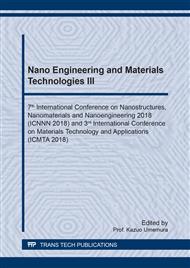p.167
p.173
p.178
p.185
p.190
p.195
p.200
p.207
p.212
Effect of Die Pressure and Injection Speed on Rheo-Die Casting of A356-SiC Composite
Abstract:
In this study, effect of die pressure and injection speed on hardness and microstructure in rheo-die casting of A356-SiC composite was investigated. The master A356-SiC composite was first produced by the mechanically stirred casting. SiC-15 micron particle was added 15 wt% in the molten A356. Master composites were then remelted at 610-615 °C. Then the slurry was transferred to a ladle and injected into the die. The Injection speeds were 3 and 4 m/s and die pressures were 11 and 12 MPa. Slurry was injected into a rod of 16×15.6×205 mm. Samples were then subjected to T6 treatment: solution treated at 540 °C for 1 h, water quenched then aged at 135 °C for 12 h. The result showed that hardness increased with increasing both speed and die pressure. At speed of 3 m/s and die pressure of 11 MPa which was an injection condition recommended for the molten A356, rheo-casted sample exhibited uneven filling at the end of the rod. When both speed and die pressure increased, samples were successfully and evenly filled the die cavities. Brinell hardness tests were performed in both as-rheo casted and T6 conditions. In as-rheo casted condition, the maximum hardness value of 82.16 HB obtained from a sample rheo-casted with speed of 4 m/s and die pressure of 12 MPa. A microstructure in cross section area of a rod revealed a uniform distribution of SiC particles in the A356 matrix. After T6, hardness value of composites increased approximately 15.6%.
Info:
Periodical:
Pages:
190-194
Citation:
Online since:
March 2019
Authors:
Price:
Сopyright:
© 2019 Trans Tech Publications Ltd. All Rights Reserved
Share:
Citation:


